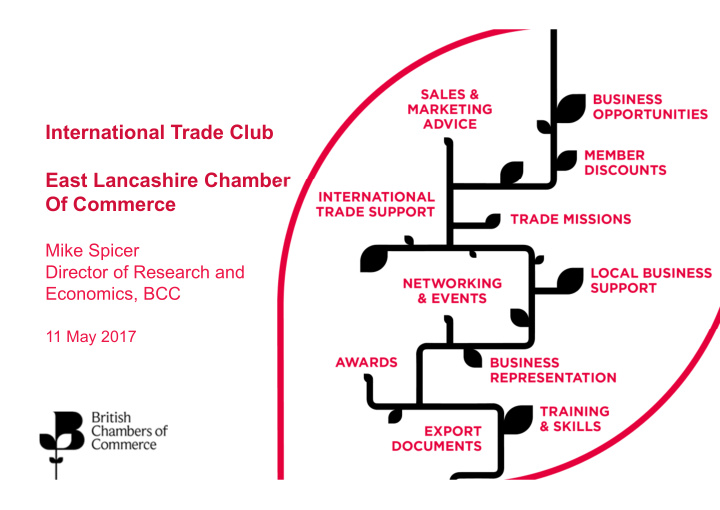



International Trade Club East Lancashire Chamber Of Commerce ����������� ������������������������� �������������� �����������
Today 1. Introducing the BCC 2. Reflections on the current political context… 3. Brexit update: ‘Negotiating Principles’ for the UK Chamber Network
INTRODUCING BCC
�������������������������������� 59% 10 employees <10 of members employ less than Local and national PR opportunities Local thought leadership platforms Our Members employ 5 MILLION PEOPLE National, 27% of UK businesses regional, local 20% with 50#250 52 BENEFITS employees are of UK businesses Chamber members with 250+ Accredited employees are Chambers Chamber members
Representing Chamber member views 1. Gathering and synthesising member views 2. Parliamentary and government engagement 3. Media interventions
REFLECTIONS ON CURRENT POLITICAL CONTEXT3
Business Manifesto: ‘Brexit and Beyond’ launched on 2 May Chamber business communities across the UK will judge the next government against five key criteria: � Business Environment: Lower costs, higher skills � Local Growth: Unlock business growth across all regions and nations � Infrastructure: Revolutionise physical and digital connectivity � Trade: Stronger practical support alongside trade deals � Brexit: The best possible deal between the UK and the EU
Business Manifesto: ‘Brexit and Beyond’ launched on 2 May The Chamber Network’s priorities for the next UK government include: � Deliver frictionless future trade arrangements with the EU, and ensure that business continue to benefit from existing Free Trade Agreements (FTAs). � No new upfront taxes on businesses for the duration of the next Parliament. � Develop a new UK regional funding system with maximum local autonomy, a strong voice for business and focus on economic growth. � Deliver promised investment in road and rail infrastructure, and ensure businesses in all parts of the UK have access to world-class digital infrastructure.
BREXIT UPDATE: WHAT WE KNOW SO FAR3
What we know from this government � UK will not seek continued single market membership � Will seek a new customs agreement with the EU � UK Parliament will vote on the final EU deal before it comes into force � Government wants “phased process of implementation” after Brexit, but not “unlimited transitional status” � Cannot conclude Free Trade Agreements with Third Countries yet (until UK leaves EU), but can begin to scope them out � The number of EU citizens coming to the UK will be controlled � UK-wide solution, with Devolved Administrations playing key role � Bring in as much EU law as possible into UK law in the first instance
Timeline – the key dates so far3 � 29 March – Theresa May triggered Article 50 � 31 March – Donald Tusk presented draft negotiating guidelines for to EU-27 � 5 April – European Parliament adopts resolution setting out redlines for negotiations � 23 April - Marine Le Pen and Emanuel Macron voted into final round of French Presidential election � 29 April – European Council (minus UK) adopted negotiating guidelines � 7 May – French President elected
Timeline – the key milestones to come (subject to change) � May-June 2017 – General Affairs Council instructs European Commission to start negotiations, with David Davis leading for the UK and Michel Barnier on the other side � 24 September 2017 – German Chancellor elected � October 2018 – Negotiations reach exit agreement � End 2018 – UK Parliament votes on deal � Early 2019 – European Parliament gives its consent (majority of members present, including UK MEPs) � Early 2019 – General Affairs Council agrees exit agreement by qualified majority voting (20 of 27 member states, UK has no vote) � March 2019 - UK leaves EU with or without a deal: if a deal then transitional phase starts and trade talks continue; if no deal then WTO rules apply to UK-EU trade � June 2019 – European Parliament elections leading to new parliament and Commission
BREXIT UPDATE: UK CHAMBER NETWORK NEGOTIATING PRINCIPLES
Business Brexit Priorities: launched on 28 February � BCC published a business blueprint for the UK government ahead of the upcoming Brexit negotiations. � Business Brexit Priorities synthesizes feedback from over 400 businesses at 16 Chamber-hosted focus groups, along with nearly 20,000 responses to Chamber surveys. It puts forward priorities for action across seven key areas where business communities want practical solutions and certainty. � Key message: put practicality at heart of negotiations and in communications to business community
Priorities for negotiation � Labour Market: the government should provide certainty for businesses on the residence rights of their existing EU workers, provide clarity on hiring from EU countries during the negotiation period, and avoid expensive and bureaucratic processes for post-Brexit hires from the EU � Trade: the government should aim to minimise tariffs, seek to avoid costly non-tariff barriers, grandfather existing EU free trade agreements with third countries, and expand the trade mission programme � Customs: the government should develop future customs procedures at the UK border in partnership with business, seek to maintain the UK’s position as an entry point for global businesses to Europe
Priorities for negotiation � Tax: the government should guarantee that HMRC is appropriately resourced to help businesses through the transition process, and provide clarity on whether VAT legislation will continue to mirror current core VAT principles � Regulation: the government should ensure stability by incorporating existing EU regulations into UK law and maintaining these for a minimum period following Brexit, and ensure that product standards are aligned with, and recognised by, the EU to keep UK products competitive � EU funding: the government should maintain UK access to the European Investment Bank, and ensure there is no funding ‘cliff-edge’ for areas in receipt of EU funding � Northern Ireland: the government must avoid any return to a hard border, so that businesses can move people and goods as freely as possible.
QUESTIONS?
Contact Mike Spicer ���������������������������������� ����������� !����������!������"�#� ������������!��������������� $%�&�����'����� (�������)�*�+,� -��.//�0�1�����$%/�%2�� 333�!����������!������"�#�
Recommend
More recommend